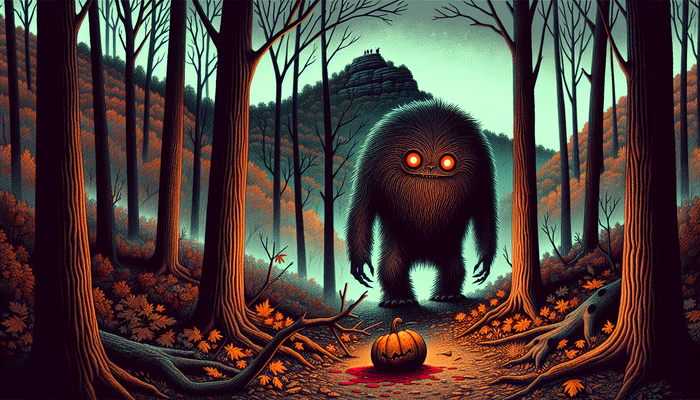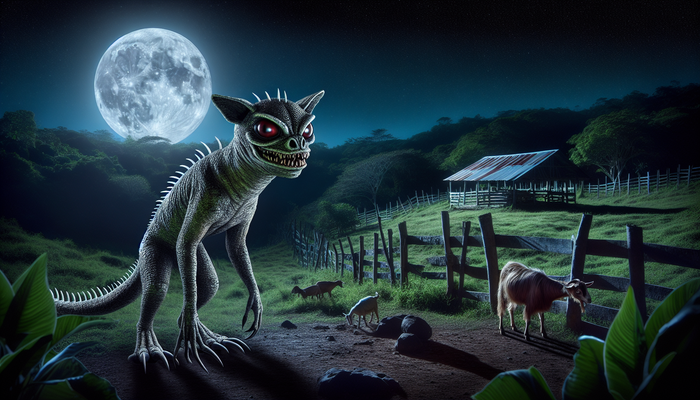Mississippi Cryptids: From Swamp Monsters to Alien Encounters

By Oliver Bennett, Bigfoot Researcher and Teacher
In the shadowy corners of our world, where the boundaries between reality and imagination blur, cryptids reign supreme. These elusive creatures, often whispered about but rarely seen, have captivated the human psyche for centuries. From the dense forests of the Pacific Northwest to the misty moors of Scotland, tales of mysterious beasts have permeated folklore and ignited the curiosity of adventurers and researchers alike. But there is one place, nestled in the heart of the American South, where the concentration of cryptid activity seems to reach a fever pitch: the state of Mississippi.
As a lifelong student of the unexplained, I have always been drawn to the rich tapestry of cryptid lore that permeates Mississippi's landscape. This state, with its sprawling swamps, lush forests, and winding rivers, seems to be a magnet for all manner of strange and wondrous creatures. It is a place where history and folklore intertwine, where ancient Native American legends meld with modern-day sightings to create a kaleidoscope of the bizarre and the beautiful.
In this article, we will embark on a journey through the mysterious realm of Mississippi cryptids, exploring some of the most intriguing and well-documented cases that have emerged from this enigmatic state. From the chilling Pascagoula River Alien abduction to the elusive Chatawa Monster, from the vengeful Yazoo River Mermaid to the otherworldly Dixie Ghost Lights, we will delve into the stories that have captured the imaginations of Mississippians for generations. Along the way, we will examine the historical and cultural context of these legends, ponder the theories that seek to explain them, and consider what these cryptids might reveal about our own relationship with the unknown. So, dear reader, prepare to step into a world where the line between myth and reality is delightfully blurred, and where the creatures of our wildest dreams (and nightmares) just might be lurking around the next bend in the river.
The Pascagoula River Alien Abduction: A Close Encounter of the Mississippi Kind
Our journey begins with one of the most harrowing and well-documented cryptid encounters in Mississippi history: the Pascagoula River Alien abduction. The date was October 11, 1973, and two men, Calvin Parker and Charles Hickson, were enjoying a peaceful night of fishing on the banks of the Pascagoula River. Little did they know that their lives were about to be forever changed by an encounter with the unknown.
As the men cast their lines into the murky waters, they suddenly noticed a strange, bluish light emanating from the river. At first, they assumed it was just a reflection of the moon, but as the light grew closer, they realized that it was attached to a bizarre, egg-shaped craft hovering just above the water's surface. Before they could react, three humanoid creatures emerged from the craft and floated towards them, their movements fluid and otherworldly.
Parker and Hickson found themselves paralyzed, unable to move or cry out as the creatures grabbed them with their claw-like hands and levitated them into the waiting craft. Once inside, the men were subjected to a thorough physical examination, their bodies probed and prodded by strange instruments. The experience seemed to last an eternity, but in reality, it was over in a matter of minutes. The creatures deposited the men back on the riverbank, and the craft disappeared into the night sky as quickly as it had arrived.
The Pascagoula River Alien abduction story quickly made headlines around the world, and Parker and Hickson found themselves at the center of a media firestorm. Many dismissed their tale as a hoax or a hallucination, but those who interviewed the men were struck by the sincerity of their account and the genuine fear in their eyes. Parker, in particular, was so traumatized by the experience that he largely withdrew from public life, while Hickson spent the rest of his days trying to make sense of what had happened to them.
In the years since the abduction, countless researchers, UFO enthusiasts, and skeptics have pored over the details of the case, trying to determine what really happened that fateful night on the Pascagoula River. Some believe that Parker and Hickson were the victims of a genuine extraterrestrial encounter, while others point to the similarities between their story and other alien abduction narratives as evidence of a cultural phenomenon rather than a physical reality. Regardless of where one stands on the question of the abduction's veracity, there is no denying the impact that this strange tale has had on the landscape of Mississippi cryptid lore. It remains one of the most compelling and unsettling cases of its kind, a reminder that the boundaries of our understanding are perhaps more porous than we would like to believe.
The Chatawa Monster: Mississippi's Bigfoot
From the cosmic to the terrestrial, our next stop on the Mississippi cryptid tour is the legend of the Chatawa Monster, a hulking, ape-like creature said to roam the dense forests surrounding the small town of Chatawa. The origins of this particular cryptid are murky, but local folklore suggests that the monster may have escaped from a circus train that derailed near the Tangipahoa swamps in the early 20th century. Some even speculate that the creature might be a surviving member of a species of giant primate thought to have gone extinct eons ago.
Eyewitness accounts of the Chatawa Monster paint a picture of a truly fearsome beast. Standing upwards of eight feet tall and covered in shaggy, dark hair, the creature is said to emit a foul odor that can be detected from miles away. Its piercing screams echo through the forest at night, sending shivers down the spines of all who hear them. Perhaps most unsettling are the massive, three-toed footprints that the monster leaves in its wake, some measuring over 20 inches in length.
One of the most intriguing aspects of the Chatawa Monster legend is its apparent connection to the nearby St. Mary of the Pines school. This Catholic girls' school, which operated from the early 1900s until the 1980s, was a popular destination for New Orleans families seeking a quality education for their daughters in a more rural setting. Over the years, countless students and faculty members reported strange sightings and encounters with a large, hairy creature lurking at the edge of the school's property. Some even claimed to have found tufts of the monster's hair snagged on the barbed wire fence that surrounded the campus.
Despite the abundance of eyewitness accounts, hard evidence of the Chatawa Monster's existence remains elusive. No clear photographs or video footage of the creature have ever surfaced, and attempts to track its movements through the forest have yielded little in the way of concrete proof. Skeptics argue that the legend is nothing more than a local tall tale, embellished over the years by overactive imaginations and the human penchant for the fantastic. Believers, on the other hand, point to the consistency of the sightings and the sheer volume of reports as evidence that there is something truly strange afoot in the woods around Chatawa.
As a researcher, I find myself fascinated by the Chatawa Monster legend not only for its cryptozoological implications but also for what it reveals about the role of folklore in shaping community identity. The monster has become a sort of mascot for the town of Chatawa, a source of pride and a testament to the resilience and quirkiness of its inhabitants. In a way, the legend serves as a reminder that even in our modern, hyper-connected world, there are still pockets of mystery and wonder waiting to be explored, if only we have the courage to venture into the shadows.
The Vengeful Siren: Yazoo River Mermaid
From the land to the water, we now turn our attention to one of Mississippi's most tragic and haunting cryptid legends: the Yazoo River Mermaid. According to local lore, this mysterious creature was once a beautiful young woman who fell in love with a handsome riverboat captain. The two were inseparable, and it seemed as though their happiness would last forever. But fate had other plans.
One day, the captain's ship returned to port without him. The young woman, frantic with worry, searched the riverbanks for days, but there was no sign of her beloved. As the weeks turned into months, she began to lose hope. In her despair, she threw herself into the murky waters of the Yazoo River, determined to be reunited with her lost love in death.
But the river had other plans for her. As her body sank beneath the surface, a strange transformation took place. Her legs fused together, forming a shimmering fish tail. Her skin took on a greenish hue, and her once-beautiful face became twisted with rage and sorrow. She had become a mermaid, but not the kind that graces the pages of fairy tales. No, this mermaid was a vengeful siren, determined to lure men to their doom as punishment for her own broken heart.
Over the years, countless tales have emerged of unfortunate souls who have fallen victim to the Yazoo River Mermaid's charms. Fishermen speak of a haunting melody that drifts across the water on moonlit nights, a song so beautiful that it compels them to abandon their boats and swim towards its source. Those who are lucky enough to resist the siren's call report glimpsing a shadowy figure beneath the surface, a woman with flowing hair and a fish's tail, her eyes glinting with malice.
As with many cryptid legends, the story of the Yazoo River Mermaid is difficult to untangle from the broader tapestry of regional folklore. Mermaids and other aquatic humanoids have been a staple of mythology for centuries, and it is likely that the Yazoo River legend is a localized variation on this ancient archetype. Some researchers have even suggested that the mermaid story may have originated as a cautionary tale, a warning to young women about the dangers of falling in love with men who are bound to the river and its fickle currents.
Regardless of its origins, the legend of the Yazoo River Mermaid has left an indelible mark on the culture and imagination of the Mississippi Delta region. It is a reminder of the power of love and loss, and of the strange and often tragic ways in which the human experience can intersect with the natural world. For those who find themselves drawn to the water's edge on a moonlit night, it is also a warning to keep one's wits about them, lest they fall victim to the siren's deadly embrace.
The Honey Island Swamp Monster: A Cryptid of the Bayou
Moving southward from the Yazoo River, we come to one of the most iconic and enduring cryptid legends of the Gulf Coast region: the Honey Island Swamp Monster. This massive, bipedal creature is said to inhabit the dense, murky swamps that straddle the border between Louisiana and Mississippi, a region known for its rich history, vibrant culture, and, of course, its myriad tales of the strange and unexplained.
According to eyewitness accounts, the Honey Island Swamp Monster is a truly fearsome sight to behold. Standing upwards of seven feet tall and weighing in at over 400 pounds, the creature is covered in shaggy, grayish-brown hair that hangs in matted clumps from its muscular frame. Its face is said to be a bizarre hybrid of human and animal features, with deep-set, glowing red eyes and a mouth filled with sharp, jagged teeth. Perhaps most unsettling of all are the monster's hands and feet, which are described as being distinctly reptilian in appearance, with long, curved claws and scaly, greenish skin.
The origins of the Honey Island Swamp Monster are shrouded in mystery, but there are no shortage of theories as to its true nature. Some believe that the creature is a remnant of a prehistoric species of ape that somehow managed to survive the ravages of time and evolution, adapting to the unique challenges of the swamp environment. Others speculate that it may be the result of a secret government experiment gone horribly wrong, a hybrid of human and animal DNA created in a laboratory and then released (or escaped) into the wild.
One of the most compelling pieces of evidence for the Honey Island Swamp Monster's existence is a series of footprint casts taken by a local hunter named Harlan Ford in the 1970s. These casts, which measure over 12 inches in length and show clear impressions of the creature's clawed toes, have been studied by cryptozoologists and skeptics alike, with some claiming that they represent irrefutable proof of the monster's reality. Others, however, have dismissed the casts as elaborate hoaxes, pointing to inconsistencies in the prints and the lack of any accompanying physical evidence, such as hair or scat samples.
Despite the ongoing debate over its authenticity, the legend of the Honey Island Swamp Monster has taken on a life of its own in the popular imagination. The creature has been featured in countless books, documentaries, and television shows, and has even inspired a thriving tourism industry in the swamps of Louisiana and Mississippi. Visitors can take guided "monster hunts" through the bayous, learning about the history and ecology of the region while keeping a watchful eye out for any signs of the elusive beast.
As a cryptozoologist, I find the Honey Island Swamp Monster to be a particularly fascinating case study, not only for its potential biological implications but also for what it reveals about the human relationship to wilderness and the unknown. In many ways, the legend of the monster is a reflection of our own deep-seated fears and anxieties about the natural world, a manifestation of the primal terror that lurks just beneath the surface of our carefully constructed civilizations. At the same time, however, the Honey Island Swamp Monster is also a symbol of the enduring mystery and wonder of the wild, a reminder that even in our age of satellite imagery and GPS tracking, there are still corners of the earth that remain largely unexplored and untamed.
The Skunk Ape: Florida's Bigfoot Cousin Visits Mississippi
Continuing our exploration of the Gulf Coast's cryptid menagerie, we come to a creature that is often overshadowed by its more famous cousin, the Sasquatch of the Pacific Northwest. I am speaking, of course, of the Skunk Ape, a large, foul-smelling, bipedal primate that is said to roam the swamps and forests of Florida, as well as parts of neighboring states like Mississippi and Alabama.
The Skunk Ape gets its name from its most distinctive feature: a powerful, musky odor that has been likened to a combination of rotten eggs, skunk spray, and wet dog. This odor is said to be so strong that it can be detected from miles away, and has been known to linger in the air for hours after the creature has passed through an area. Some researchers have even suggested that the Skunk Ape may use its scent as a form of territorial marking, much like other primates such as gorillas and orangutans.
In terms of physical appearance, the Skunk Ape is often described as being similar to the classic image of Bigfoot, with a few key differences. It is generally smaller in stature, standing between 5 and 7 feet tall, and has shorter, reddish-brown hair that is less shaggy than that of its Pacific Northwest counterpart. Its face is said to be more ape-like than human, with a pronounced brow ridge, flat nose, and large, powerful jaws.
Sightings of the Skunk Ape in Mississippi are relatively rare compared to those in Florida, but there have been a handful of intriguing reports over the years. In the early 1980s, for example, a group of hunters in the Pascagoula River Wildlife Management Area claimed to have encountered a large, hairy, bipedal creature that emitted a powerful, musky odor.
From Bigfoot to UFOs: Hangar 1 Publishing Has You Covered!
Explore Untold Stories: Venture into the world of UFOs, cryptids, Bigfoot, and beyond. Every story is a journey into the extraordinary.
Immersive Book Technology: Experience real videos, sights, and sounds within our books. Its not just reading; its an adventure.



























